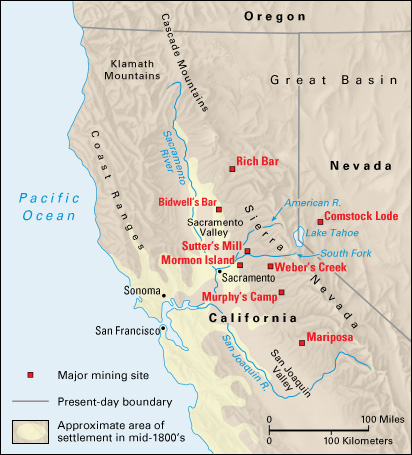California gold rush was a period in the mid-1800’s when large numbers of people came to California seeking gold. It began in 1848, after James Marshall discovered gold at Sutter’s Mill, California. The gold rush attracted would-be miners from around the world, and California’s population increased rapidly. The United States had just taken control of the region in 1848, at the end of the Mexican War. California became a U.S. state in 1850.
Background and discovery.
John Sutter, a merchant from Switzerland, came to California’s Sacramento Valley in 1839. He built a fort, complete with a farm, a ranch, and workshops. Sutter planned to build a sawmill on a bank of the South Fork of the American River, nearly 50 miles (80 kilometers) northeast of the fort. In 1847, he chose James Marshall, a New Jersey-born carpenter, to supervise the construction of Sutter’s Mill (see Marshall, James Wilson ).
Marshall’s workers dug a long trench to divert water from the river to the mill. On Jan. 24, 1848, Marshall walked along the trench and found specks of gold there. Rumors about the gold discovery spread over the next several weeks. After Marshall’s men completed the sawmill on March 11, they began to prospect (explore the region) for gold full-time.
The gold rush begins.
By 1849, the gold rush was underway. The gold-seekers became known as Forty-Niners. The first Forty-Niners reached San Francisco, the nearest port, on the steamer California on Feb. 28, 1849. Other ships soon followed. Prospectors also arrived in covered wagons by way of the Oregon Trail and the California Trail. Others came from Europe, Latin America, and China.
Within a year, San Francisco, a small town at the start of the gold rush, grew to a city of about 25,000. The rapid growth brought about changes in the area’s culture. Theaters prospered, as did halls of gambling and prostitution.
Additional discoveries.
After the discovery at Sutter’s Mill, prospectors struck gold at several sites in the western foothills of the Sierra Nevada. Important sites included the Murphy’s Camp and Mariposa claims to the south and Bidwell’s Bar and Rich Bar to the north.

Many early prospectors separated gold from gravel and rock by rinsing gold-bearing soil in a shallow hand-held pan. Prospectors also used a simple wooden device known as a cradle or rocker. By the mid-1850’s, gold-seeking became less profitable for small groups of prospectors. However, larger mining companies, with more advanced instruments, continued to extract gold buried deep beneath the land’s surface.
Many historians identify 1859 as the end of California’s gold rush. That year, silver and gold deposits were discovered at the Comstock Lode in west-central Nevada. See Comstock Lode .
Effects of the California gold rush.
The discovery of gold and the increase in population transformed life in California. Many prospectors made fortunes from gold. Others, however, were unsuccessful. Many gold-seekers became farmers or ranchers.
Life for California’s Indian groups changed greatly as new residents flooded into their homelands. Violence between Indians and prospectors was common. Many Indians were subjected to forms of enforced labor. Thousands died of smallpox and other diseases.
Gold-seekers increased California’s population from about 15,000 early in 1848 to nearly 100,000 by the end of 1849. In 1850, California had enough people to be admitted as the Union’s 31st state. By 1860, California was home to about 380,000 people.
